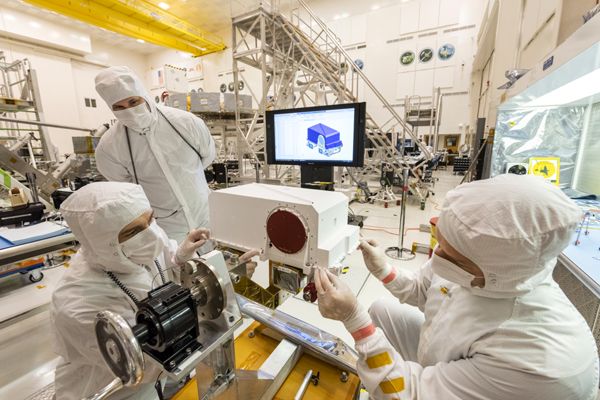
NASA / JPL - Caltech
NASA's Mars 2020 Gets HD Eyes (News Release - May 31)
One of the first operations the Mars 2020 rover will perform after touching down on the Red Planet's Jezero Crater on Feb. 18, 2021, will be to raise its remote sensing mast (RSM), which carries important optics and instrumentation.
In this picture - taken on May 23, 2019, in the Spacecraft Assembly Facility's High Bay 1 clean room at the Jet Propulsion Laboratory near Pasadena, California - engineers re-install the cover to the RSM head after integration of two Mastcam-Z high-definition cameras. Visible below the red lens cover is the left Mastcam-Z camera (with the "Remove Before Flight" labels); support equipment blocks the right Mastcam-Z from view. The RSM and its twin cameras will be installed on the rover's deck the week of June 3, 2019.
Mastcam-Z is a multispectral, stereoscopic imaging instrument that will enhance the Mars 2020 rover's driving and core-sampling capabilities. It will also enable science team members to observe textural, mineralogical, structural and morphologic details in rocks and sediment at any location within the rover's field of view, helping them piece together the planet's geologic history.
"Mastcam-Z will be the first Mars color camera that can zoom, enabling 3D images at unprecedented resolution," said Mastcam-Z Principal Investigator Jim Bell of Arizona State University in Tempe. "With a resolution of three-hundredths of an inch [0.8 millimeters] in front of the rover and less than one-and-a-half inches [38 millimeters] from over 330 feet [100 meters] away - Mastcam-Z images will play a key role in selecting the best possible samples to return from Jezero Crater."
Mastcam Z's capabilities are not the only firsts of the mission. Mars 2020 will be the first spacecraft in the history of planetary exploration with the ability to accurately retarget its point of touchdown during the landing sequence. And the rover carries a sample-caching system that will collect Martian rock and soil samples and store them on the planet's surface for retrieval and return to Earth by subsequent missions.
Mars 2020 will launch from Cape Canaveral Air Force Station in Florida in July of 2020.
JPL is building and will manage operations of the Mars 2020 rover for the NASA Science Mission Directorate at the agency's headquarters in Washington.
If you want to send your name to Mars with NASA's 2020 mission, you can do so from now until Sept. 30, 2019. Add your name to the list and obtain a souvenir boarding pass to Mars here:
https://go.nasa.gov/Mars2020Pass
Source: Jet Propulsion Laboratory

No comments:
Post a Comment